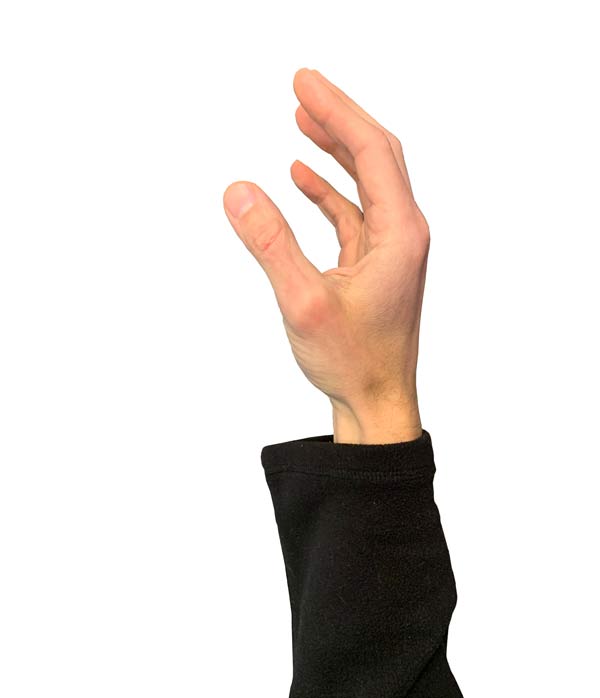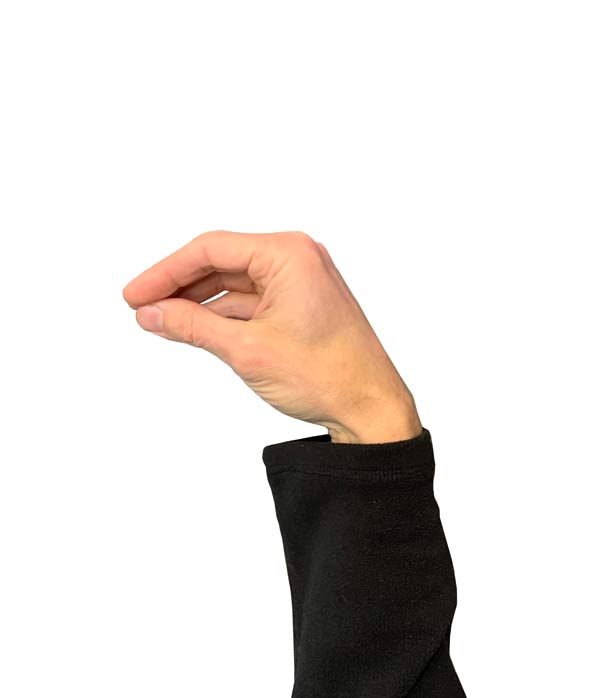Calming the Nervous System, Integrating the Hands and Eyes (37m, Patrons)
Back-lying, using a "bell hand" movement to differentiate and integrate the hands, eyes, and breath. This lesson is a powerful tool for self-regulation and reorganization, stimulating the parasympathetic nervous system and shifting us away from "fight or flight" and toward "rest and digest". Begins with a 2-minute introduction to this lesson’s particular bell hand movement (see photos below the lesson notes).
We offer over 50 free lessons, but this one's just for our Patron-level donors. You can learn about it in the free lesson notes and comments below, but to access the audio you’ll need to join The FP as a Patron. Learn more
forearm vertical, softly open hand, “unclosed”

droop your wrist, bring your fingertips together

Got a question for Nick, or a thought about this lesson?
Use the comments section below! Public comments build our community and help search engines find us.




Love this lesson! This will be one I return to regularly.
Thank you Nick. Wonderful. So soothing and rich. At some point during the lesson the idea for a “bell/e foot” variation came to mind. Just by analogy, allowing the foot to gently open and close, softening at the ankle joint, letting the toes gently come together and apart. I am thinking about following along this lesson and simply replacing the word hand by foot? Maybe lying on the belly instead, with the lower legs vertically balanced? Or would you advise against messing with the eye-hand coordination by turning this into an eye-foot experiment?
I love that you thought of this foot connection spontaneously! No reason not to “mess with” any ATM that you like: as long as the movements are serving your learning and curiosity you’re on a good Feldenkrais track.
Since you’re encountering this lesson when it was unlocked for all listeners as a “peek at Patron perks” I have to mention another lesson: the Related Lessons tab above points to our other two bell hand lessons, including One Bell Hand / Two Bell Hands…and Feet (Patrons). Sometime if/when the time is right to sign up for a month of Patron benefits you should definitely try that lesson!
I may borrow “bell/e” sometime…that’s useful! Thanks for listening.
Update: A newer lesson, Integrating the Feet, Torso, Head, and Breath: Connecting to the Earth (44 min, Patrons), explores foot/ankle/toe movements in more depthh.
After doing this lesson, I felt completely inert, deeply relaxed.
I did the bell hands at the dentist last week while getting a tooth drilled and a filling put in. It was the most relaxing dental appt I’ve ever had!
I realized when I was breathing in while my hand was opening I would breathe through the chest while the opposite way I would breathe through the belly.
I had some problems with loggin in .I got phantastic ,rapid help with my questions
about how to manage the computer from Nick and Eileen! Thank you so much!!.
I could really enjoy this lesson which I consider ingenious.I am happy to be able to login in easily now so that I can really incorporate this lesson. I will need it!
Excellent! We try to keep our technology running smoothly for everyone so you can simply enjoy the lessons. I love this one too! Glad it connects with you.
just checking. When the hand is “unclosed,” the palm is facing the wall beneath my feet, not the side wall on the other side. Yes?
I fell asleep the first time, but it was a lovely nap. Looking forward to the second time doing it.
Yes: palm facing the wall beneath your feet is usually the most neutral position for folks for “unclosed” hands, assuming your elbows are positioned as described (arms first formed a “letter T,” straight out to the sides at the height of your shoulders, then elbows bent 90 degrees).
And yup, this type of study is particularly soporific! Some folks use it in the middle of the night for insomnia.
What an interesting lesson! I found my right leg, which is biased toward extreme external rotation, spontaneously moves to a straight more internal rotation in kind of a subconscious “herky jerky” movement while exhaling/closing my right hand. Like an auto correct. How cool!
This is a very interesting lesson. The hand gesture reference when the fingers tips are all touching is also a called the Semana Mudra or the Semana Vayu Mudra in yoga. The mudra is said to balances the flow of energy in the navel region, improve digestion, absorption, and the functioning of the stomach and the intestines. I’ve been studying yoga for a handful of years now and as soon as my finger tips touched together I was able to feel the subtle energy of this mudra on my digestion and in my nervous system. When we think about the parasympathetic nervous system going into the rest and digest mode, this hand gesture made a lot of sense to me from a yoga and ayurvedic point of view. It’s also the gesture of the hands when eating (without forks) so taking in nourishment. I found myself wanting to draw my head toward my hands as well.
Thank you for sharing all that! I’m sure I won’t be the only one who finds that very interesting. What a wonderful natural connection yoga makes with this gesture!
What a great gentle & pervasive lesson! Loved it.
Only 3 hrs sleep per night for about a week now, a lot going on in my life and even more in my mind,
common thing for an HSP (highly sensitive person)
pondering about this and that, full moon time, high temperatures and humidity.
I can’t find my sleeping rhytm.
Sleepless again tonight your mail about anxiety pops up in my mind and reminds me of this lesson, one of my favorites.
This lesson has always been such a great help, 37min, nice for in between – so I turn it on.
It takes only 3 min (actually 3) to get so tired thanks to your soothing voice.
I slept totally relaxed for the rest of the night.
Thanks Nick, our little study group enjoyed this lesson, found it very nice and relaxing.
By the way, when I teach versions of this move in ATMs I coordinate the wrist and fingers the other way round- when the wrist flexes, fingers spread, when the wrist extends (or straightens) the fingers curl together.
Thank you for making all these wonderful lessons available.
Thanks for your comment! Yes, both versions are taught, and both are useful. I use the version you describe in the second half of Getting Free with a Bell Hand (Patrons).
Loved this! Had been experiencing some headache and balance issue, and this lesson restored my equilibrium. Thank you